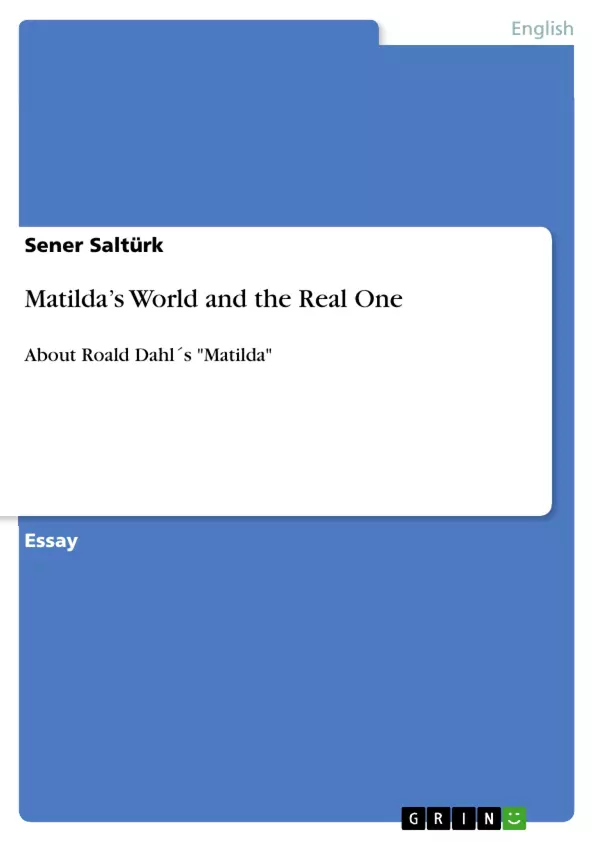[...] Though children’s books not infrequently take on the subject of children suffering under their own weaknesses, the major difference between the world in these books and the real world is that in the latter they cannot define the rules, nor can they rule. In a fictional world, however, they can become heroes and masters of their own fate, or even, anything and anyone. Here children can become free in an existential sense of the word. In order to reach this freedom the child must cope with a number of different and quite difficult and dangerous tasks. But what sort of world is it actually? An aforementioned ersatz world, a parallel world or just a copy of the real world they are desperately striving to escape from?
In any case, this fictitious worlds do not only include the “things in it” but quite frequently (comp. above mentioned Harry Potter, Huck Finn etc.), focus strongly on their protagonists, a fictional child that is in many ways like any other child save in one thing: he or she is capable of ‘doing things’ the others cannot, thus being enabled to change the status quo of things (or of the world). This status quo, i.e. conflicts children generally encounter, is depicted in ironic, quite often exaggerated ways that the child heroes have to face and overcome. Of course, in order to accomplish this, it takes an extraordinary child and it is no coincidence that many a ‘successful’ children’s book either carries its protagonist(s)’s name in the title or is actually named after them. As is Roald Dahl’s Matilda.
As for the world Matilda lives in, it contains many elements of different genres (such as fairy tales etc.) that I will pay my closer attention to, hoping to yield some information on what these worlds include and what makes them so attractive to children and approach to the fantasies and the fantasy world of children.
Inhaltsverzeichnis (Table of Contents)
- I. Introduction
- II. Matilda universe: what/who is real, what/who is fiction?
- III. Themes/Conflicts: "My parents are aliens"
Zielsetzung und Themenschwerpunkte (Objectives and Key Themes)
This preview aims to provide a comprehensive overview of Roald Dahl's novel "Matilda" without revealing major conclusions or spoilers. The analysis focuses on exploring the interplay between the fictional world of the book and the "real" world, examining how Dahl utilizes themes and conflicts common to many children's books, and delving into the unique characteristics of the characters and their significance.
- The relationship between the fictional world of children's books and reality
- The use of caricature in portraying characters and their connection to real-life personalities
- The exploration of universal human characteristics and vices through fictional characters
- The examination of recurring themes in children's literature, particularly those related to family dynamics, education, and overcoming injustice
- The analysis of the moral dimensions of the story, highlighting the contrast between good and evil and the importance of empathy and compassion.
Zusammenfassung der Kapitel (Chapter Summaries)
I. Introduction
This introductory chapter establishes the concept of "ersatz worlds" in children's literature, highlighting how these worlds provide a sense of freedom and escape from the complexities and limitations of the real world. The chapter discusses how children's books often portray children as capable of extraordinary feats and overcoming obstacles, with particular focus on the significance of the protagonist's name in the title of the book, as seen in Roald Dahl's "Matilda." The chapter also introduces the concept of "caricatures" in children's literature, suggesting that characters are often exaggerated representations of real-life personalities and behaviors.
II. Matilda universe: what/who is real, what/who is fiction?
This chapter explores the relationship between the fictional world of "Matilda" and reality. The author draws parallels between the characters in "Matilda" and those in George Orwell's "Animal Farm," suggesting that both works utilize characters as symbolic representations of universal human characteristics. The chapter discusses the use of caricature in portraying the characters in "Matilda," arguing that while the characters are exaggerated, they are still relatable to real-life individuals. The chapter also highlights the absence of violence in the story, despite the presence of "villains" like Miss Trunchbull, emphasizing the moral framework of the book and its suitability for children.
III. Themes/Conflicts: "My parents are aliens"
This chapter examines the recurring themes and conflicts present in "Matilda," particularly the theme of "my parents are aliens." The chapter analyzes the dysfunctional family dynamic portrayed in the novel, focusing on the neglectful and uncaring nature of Matilda's parents and their contrasting attitudes towards their children. The chapter highlights the theme of injustice, particularly as it relates to children, and explores how these conflicts are amplified and exaggerated in the fictional world of the novel. The chapter provides specific examples from the text, demonstrating how Dahl uses the "my parents are aliens" theme to explore complex social issues.
Schlüsselwörter (Keywords)
The primary keywords and focus topics of "Matilda" include: children's literature, fictional worlds, "ersatz worlds," caricature, universal human characteristics, family dynamics, education, injustice, good versus evil, empathy, and compassion.
- Quote paper
- StR Sener Saltürk (Author), 2005, Matilda’s World and the Real One, Munich, GRIN Verlag, https://www.grin.com/document/204005



